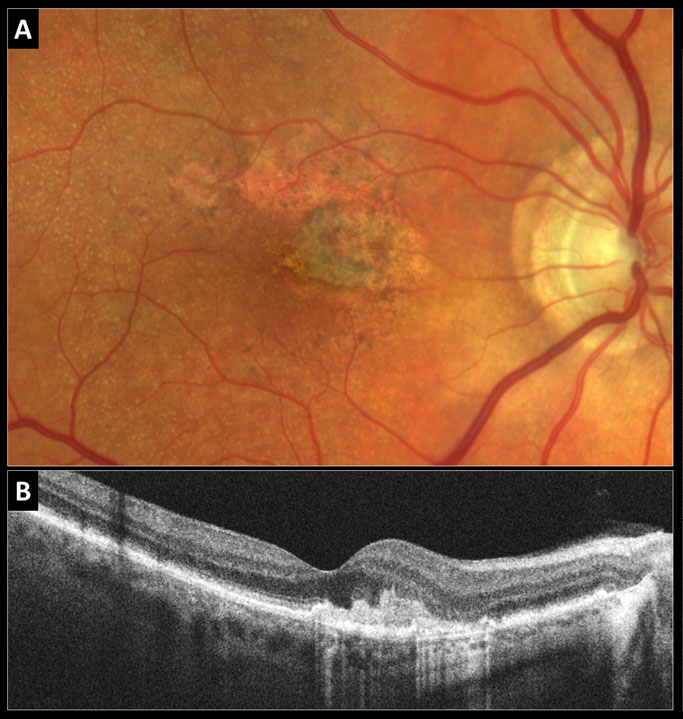 |
Inactive type 2 neovascular AMD: (A) Color photo shows the gray-green subretinal fibrovascular complex in the nasal fovea with adjacent RPE atrophy and reticular pseudodrusen. (B) Structural OCT reveals a subretinal hyperreflective fibrovascular complex and no fluid. Photo: Carolyn Majcher, OD. Click image to enlarge. |
Researchers identified a 62.7% cumulative incidence of fibrosis in a large neovascular age-related macular degeneration (wet AMD) cohort at 10 years. The findings revealed that fibrosis was more common with frequent reactivations and lower baseline visual acuity. This emphasizes the importance of prompt and proactive treatment for these patients, according to the study authors.
This retrospective, multicenter, cohort study reported incidence and risk factors for fibrosis at 10 years among wet AMD. The analysis included 225 wet AMD eyes from 207 eligible patients who underwent intravitreal anti-vascular endothelial growth factor treatment over 10 years of follow-up. Study authors reviewed the demographic and clinical data at baseline and on an annual basis.
Eligibility criteria included the following: new diagnosis of wet AMD based on fluorescein and indocyanine green angiography, visual acuity higher than 25 ETDRS letters at the time of macular neovascularization detection, initial treatment with a loading phase of three monthly intravitreal anti-VEGF injections and a minimum of 10 years of follow-up using Spectralis (Heidelberg Engineering) imaging.
The mean age at baseline was 72.1. The researchers reported an estimated fibrosis incidence rate of 8.9 per 100 person-years with a cumulative incidence of 62.7% at 10 years. Data showed that fibrotic lesions were sub-retinal pigment epithelium in 46.1%, mixed in 29.8% and subretinal in 22.7% of study participants.
The researchers also identified a number of independent factors associated with fibrosis. These included larger central subfield thickness variation, submacular hemorrhages, higher number of injections and worse baseline visual acuity. They found that type 2 macular neovascularization was significantly associated with mixed and sub-retinal fibrosis. Additionally, there was a significant decline in visual acuity over 10 years (-16.4 ETDRS letters), especially among individuals with mixed and sub-retinal fibrosis.
“Several factors associated with lesions reactivations over time were associated with increased risk of fibrosis, while better visual acuity at baseline was identified as a protective factor,” the study authors concluded in their recent American Journal of Ophthalmology paper. “This suggests that wet AMD should be treated as early as possible and that a proactive regimen avoiding recurrences should be preferred.”
Romano F, Cozzi E, Airaldi M. Ten-year incidence of fibrosis and risk factors for its development in neovascular age-related macular degeneration. Am J Ophthalmol. April 6, 2023 [Epub ahead of print]. |

